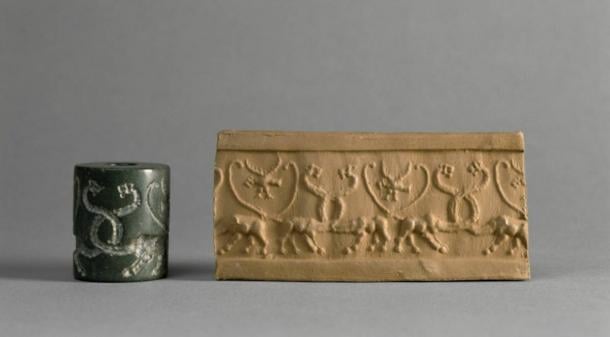🔴 Website 👉 https://u-s-news.com/
Telegram 👉 https://t.me/usnewscom_channel
Proto-cuneiform, an early sign-based script, marks a pivotal moment in human history as the precursor to the world’s first writing system, cuneiform. Emerging between 3350 and 3000 BC in the city of Uruk, located in what is now southern Iraq, this system initially arose from practical needs such as accounting. However, the exact mechanisms of how it developed have long eluded scholars.
Recent research has unveiled a fascinating link between proto-cuneiform and an earlier technology: cylinder seals. These engraved stone cylinders, when rolled across clay, left intricate designs. The transformation of these motifs into proto-cuneiform signs not only sheds light on the origins of writing but also reveals a significant cultural leap in ancient Mesopotamia.
Example of a cylinder seal (left) and its design imprinted onto clay (right) (Franck Raux © 2001 GrandPalaisRmn, Musée du Louvre/ Antiquity Publications Ltd)
Cylinder Seals: Tools of Pre-Literate Accounting
Cylinder seals, dating back to 4400-3400 BC, were not mere artistic objects. They played a crucial role in the administrative functions of early Mesopotamian societies. These seals, often associated with temple institutions, were used to track the movement and storage of goods like textiles and agricultural products. By the mid-fourth millennium BC, these seals had become integral to a growing system of accounting that preceded written records.
The significance of these seals in pre-literate society cannot be overstated. Their motifs were not arbitrary; they conveyed specific information about goods and transactions. This utilitarian function of seals suggests that they laid the groundwork for the symbolic representations that would later evolve into proto-cuneiform.
Tracing the Transformation: Seals to Signs
The study, conducted by a team of researchers from the University of Bologna and published in Antiquity, systematically compared cylinder seal motifs with proto-cuneiform signs. This research identified specific motifs related to the transport and storage of jars and cloth that directly influenced the shapes and meanings of proto-cuneiform signs.
Comparisons between netted-vessels, a distinctive plant, and a priest/ruler(?) in proto-cuneiform (A & C) and seal imagery (B) (Figure by authors/Antiquity Publications Ltd)
This continuity between the motifs on seals and the symbols in proto-cuneiform reveals a gradual, yet profound, shift from visual representation to written communication. The findings illustrate how ancient societies transitioned from using symbolic imagery for practical purposes to developing a formal writing system.
Bridging Prehistory and History
The implications of this discovery extend beyond understanding the origins of writing. It provides crucial insights into the cognitive advancements of early human societies. The leap from symbolic representation to written language represents a monumental shift in human communication and record-keeping.
Professor Silvia Ferrara from the University of Bologna emphasizes the importance of this transition:
“The conceptual leap from pre-writing symbolism to writing is a significant development in human cognitive technologies. The invention of writing marks the transition between prehistory and history, and the findings of this study bridge this divide by illustrating how some late prehistoric images were incorporated into one of the earliest invented writing systems”.
This research bridges that divide, demonstrating how late prehistoric images were seamlessly integrated into one of the earliest writing systems.
This new understanding not only enriches our knowledge of proto-cuneiform but also offers valuable tools for deciphering undeciphered signs in the script. By tracing the evolution of specific motifs from cylinder seals to written signs, scholars can better decode the meanings embedded in these ancient texts.
The transformation of cylinder seal motifs into proto-cuneiform signs underscores the innovative spirit of early Mesopotamian societies. This development highlights how practical needs drove technological advancements, culminating in one of humanity’s most significant inventions: writing. As researchers continue to explore the depths of this early script, our understanding of the dawn of written communication continues to expand.
Top image: Left; Proto-cuneiform tablets, Right; Analysis of proto-cuneiform examples. Source: Courtesy of CDLI/Antiquity Publications Ltd
By Gary Manners


